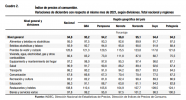please link to the studies which show 93% inflation YOY, and what, exactly, they are including in the basket for Argentina.
I would assume they would leave out health care, which is free at public hospitals,
utilities, which are both subsidized and have price controls, (the government of Argentina usually spends about 25% of its total expenditures on fossil fuel subsidies)
transportation (ie, colectivos, subte, and trains, which, again, are both subsidized and have price controls)
housing, which is, again, regulated, price controlled, subsidized, and, in the case of the 3 million or so people who squat in villas and the conurbano, basically free from rent, as long as you build it yourself.
(although I met an artist a couple of years ago who rented an apartment in the villa between San Telmo and Puerto Madero, because it was cheap and convenient- and for them, perfectly safe. So some places in villas are definitely rented. Be curious to know if those rents track inflation)
Most first world nations jigger the contents of their baskets for political reasons- for instance the USA tends to exclude changes in food and energy prices in their inflation numbers. This is exactly what you called it- cherry picking. Everybody does it. The really interesting part is what they cherry pick to get what rate of inflation. US consumer prices rose between 1% and 30%, depending on the category of good or service. Coming up with a national inflation rate will vary widely, depending on weighting, which is, I believe, complicated and not transparent at all.
I would be very interested to hear which items are used to calculate Argentina supposed 100% numbers.

